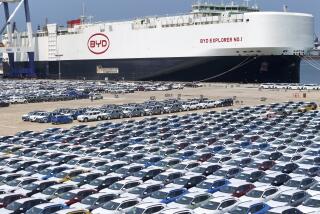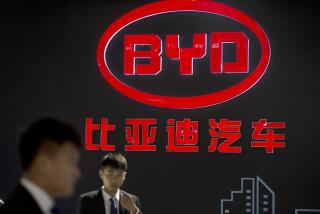Gone Car Crazy : For China, the Dawning of the Automotive Age
- Share via
BEIJING — They came by bicycle and on foot, in rickety overcrowded buses and in boxy yellow taxi vans that Beijingers call miandi , or “bread loaves.”
Only a privileged few came by private car to China’s International Automotive Industry Exhibition that ends here today after breaking records for attendance.
Sponsors said the event’s popularity reflects China’s new burning passion for the automobile.
The love affair with the car is all the more remarkable because only a handful of Chinese own one.
Only 1% of the 500,000 passenger cars sold in China last year went to private buyers. In keeping with the Chinese socialist system, most were purchased by state-owned companies or work units--although many cynics point out that government officials often regard the publicly purchased cars as their personal vehicles.
But after several years of rapid economic growth, the once-impossible dream of owning a car has inched closer to reality for many Chinese, particularly in the major cities and affluent coastal area. The government optimistically predicts that China will produce more than 3 million vehicles by the turn of the century and that many will end up in private hands.
“What is different this year,” said Hans-Jorg Geduhn, who is chief Beijing representative for the German automobile company BMW, “is that the Chinese customer is more and more recognizing that a car is not a dream anymore. It is no longer a goal that he will never reach. Everyone is making their own calculation about how long it will take before they have a car.”
For some, such as 30-year-old Zheng Jianguo, the dream has been realized.
Since buying his first car, a tiny Chinese-made compact, in 1989, Zheng has purchased a succession of six cars, each one more expensive than the last.
At the Beijing auto show Tuesday, surrounded by three bulky assistants who huddled around him protectively as he spoke on a cellular phone, Zheng was sizing up the Porsche display.
Zheng, who said he makes about $120,000 a year in the imported-auto repair business he founded eight years ago, is thinking about buying his seventh car. But he was skeptical about any immediate development of a private car market on a mass scale.
“People who belong to government work units cannot afford to buy cars,” he said. “Even if they had the money, the first thing they would do is buy an apartment. But who knows, more and more people are becoming businessmen like me.”
Even the distant possibility of someday owning a car has unleashed a car passion here that rivals mass political movements of the not-so-distant past.
Car posters are a favorite teen-age wall hanging. Driving lessons have become a rage even in carless families. Car fan magazines, including one whose title translates as Car Fan, have proliferated. Thousands of car aficionados, many of whom have never ridden in a private vehicle, poured into the exhibition center beginning last Friday to gawk at the best from the rest of the world, including all three major American companies and first-time exhibitors from the new automotive power, South Korea.
In all, 397 foreign automotive and parts firms and more than 500 Chinese companies exhibited at the show.
Participants ranged from the giant China First Automobile Group, maker of the famous Red Flag limousine favored by Chairman Mao, to Kingsmart Ltd., a Hong Kong firm that specializes in 24-karat gold-plated grills and hood ornaments.
American and Japanese manufacturers staffed their exhibits with provocatively dressed professional models and, in the case of Nissan, even held fashion shows to attract visitors. Chinese exhibitors were more demure, preferring polyester pantsuits and models recruited from the ranks of factory workers.
The foreign companies said they were there to establish a presence for the day when the China auto market takes off.
“This is a show that is not going to result in any immediate sales,” one American exhibitor said. “China’s market is not yet at that point. But China is a huge potential market, and no one can afford not to be here.”
When the six-day show ends today, sponsors expect more than 340,000 people will have attended. China has been holding annual auto shows since 1985, but attendance this year was more than double that of the 1993 show in Shanghai (153,000) and the 1992 show in Beijing (163,000).
At one point, confided Perry Tang, assistant manager of the Hong Kong marketing firm that staged the show, representatives of the Italian firm Fiat became worried that its large display might collapse under the surge of people on the supporting elevated platform.
At the General Motors exhibit, which featured a Cadillac stretch limousine and long-legged Chinese models wearing miniskirts tied at the waist with American flags, a woman narrowly avoided being pushed over a protective railing by a frenzied group seeking pamphlets on the GM line of cars.
The rush to collect the leaflets, which are often simply lists of technical details, is part of a new hobby among young Chinese to memorize and recite facts about different vehicles.
Explained one high school student who spent his first day of summer vacation at the show with two classmates, each of whom carried plastic bags bulging with materials:
“I just want to be able to recognize every car on the street, whether it is a Ford or an Audi or something else.”






